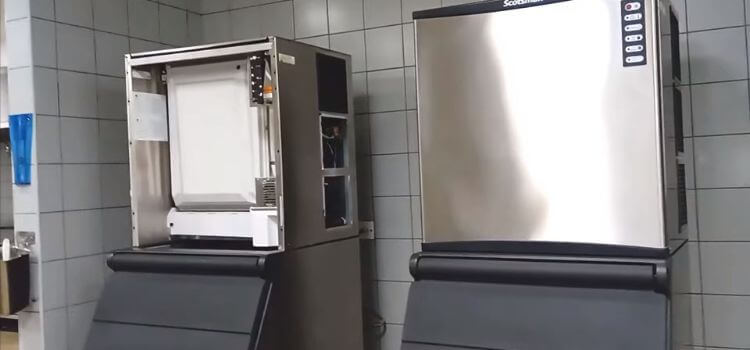Commercial ice makers are essential in restaurants, hotels, hospitals, and other commercial establishments. They are intended to produce a large volume of ice quickly, making them ideal for busy environments where ice is needed to prepare drinks and foodstuffs.
But have you ever wondered how these machines work? We’ll look at the inner workings of a commercial ice maker in this article, and we’ll understand the process of its operation.

The Basics of a Commercial Ice Maker
A commercial ice maker is a self-contained unit that combines refrigeration, water supply, and electrical components to produce ice. Depending on the model in question, it may have various types of ice, e.g.,, cubes, nuggets, flakes, or blocks. The essential components of a commercial ice maker include:
- Evaporator: This is the part responsible for freezing the water into ice.
- Condenser: It removes heat from the system and helps maintain constant temperature levels.
- Compressor: This component compresses low-pressure refrigerant gas, which flows to the condenser.
- Water Supply System: It supplies water to the machine for the ice-making process.
- Control Module: This is the brain of the ice maker, controlling and monitoring all its functions.
Understanding How Does a Commercial Ice Maker Work?
The ice-making process in a commercial ice maker involves a series of steps that work together to produce ice. Let’s take a closer look at each step:
Water supply
The water supply system in the ice maker is connected to a water source, which can either be a direct plumbing line or an external tank. The water flows into the machine and fills up the reservoir.
Freezing Process
Once the reservoir is complete, a valve opens, allowing the water to enter the evaporator, where it freezes. As the refrigerant absorbs heat from the water, it causes the temperature to drop below freezing point, turning the water into ice.
Harvesting
Once the ice is formed, a hot gas valve opens, releasing hot refrigerant gas into the evaporator. This warms up the coils and melts the edges of the ice cubes, making them easier to remove.
Removal of How Does a Commercial Ice Maker Work?
A motor then rotates the evaporator, and a scraper removes the ice from the surface. This process continues until all the ice cubes are harvested.
Storage
Then, the ice is stored in an insulated box, ready to be used.
The Role of Ice Machine Refrigerant
The refrigerant is the critical element of a commercial ice maker that allows it to produce ice. It is a liquid or gas that absorbs heat from its surroundings and converts it into a gas or vapor.
In the case of an ice maker, the refrigerant begins as a low-pressure gas and travels through the evaporator coil, absorbing heat from the water, which causes it to freeze and form ice.
The refrigerant then passes through the pump, which is compressed into a high-pressure gas and sent to the condensers.
Benefits of Using a Commercial Ice Maker
There are several benefits to using a commercial ice maker compared to traditional ice-making methods. These include:
- Time-saving: The commercial ice producer can produce a large quantity of ice, saving valuable time for busy stores in the short term.
- Consistency: The ice made by a commercial ice maker is consistent in size and shape, ensuring an efficient cooling process and uniform presentation.
- Hygiene: With sealed storage bins and automatic dispensing systems, commercial ice makers reduce the risk of contamination and maintain better hygiene.
- Efficiency: These machines use less energy than traditional methods, making them more cost-effective in the long run.
Conclusion
Commercial ice makers may seem like simple machines, but their operation involves multiple complex systems. Making ice is carefully controlled and monitored to produce high-quality ice that meets the demands of busy commercial environments.
We’ll appreciate the convenience of these machines in our daily lives more if we understand how they operate. So, next time you enjoy a refreshing drink with ice, remember the intricate process of producing it in a commercial ice maker!
Related Topics: https://foswickcollectibles.com/why-are-nugget-ice-makers-so-expensive/
Leave a Reply